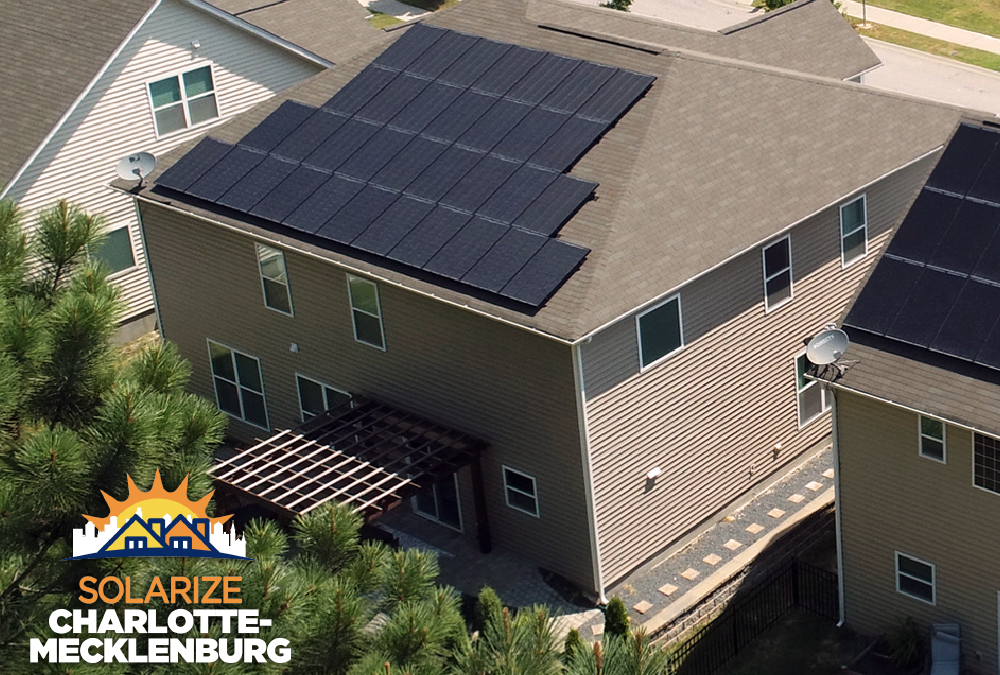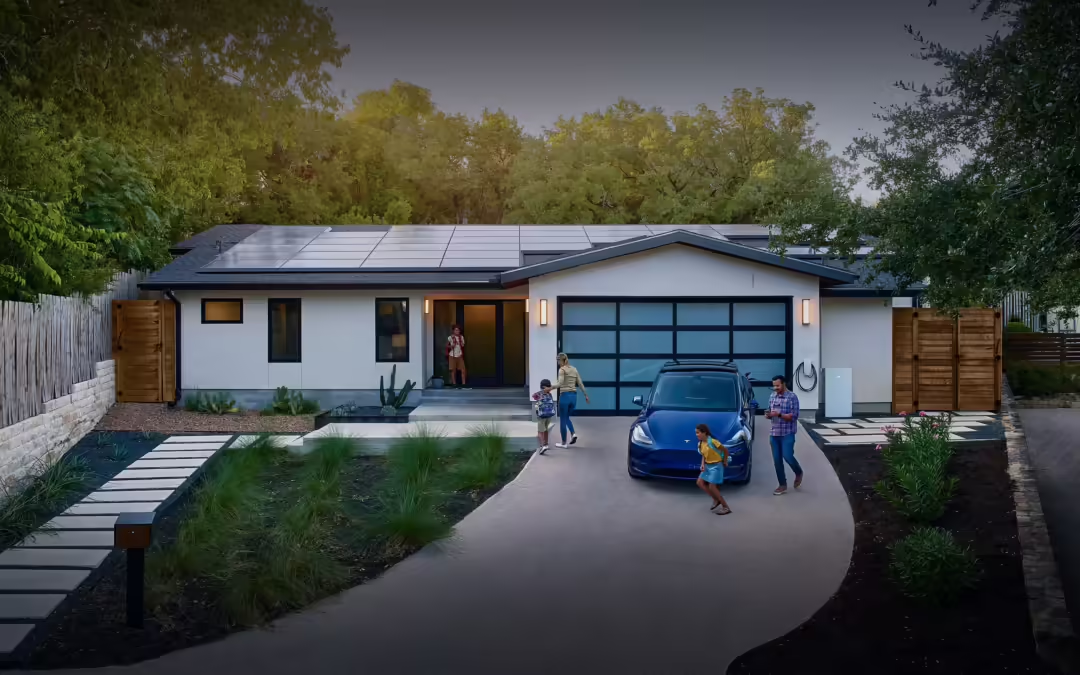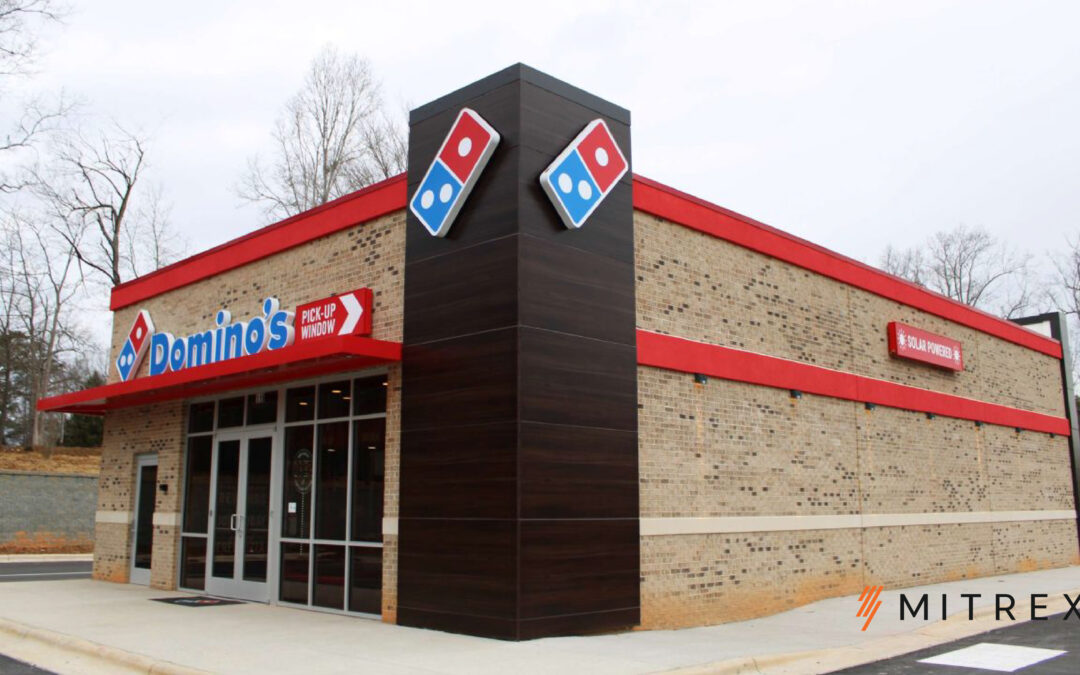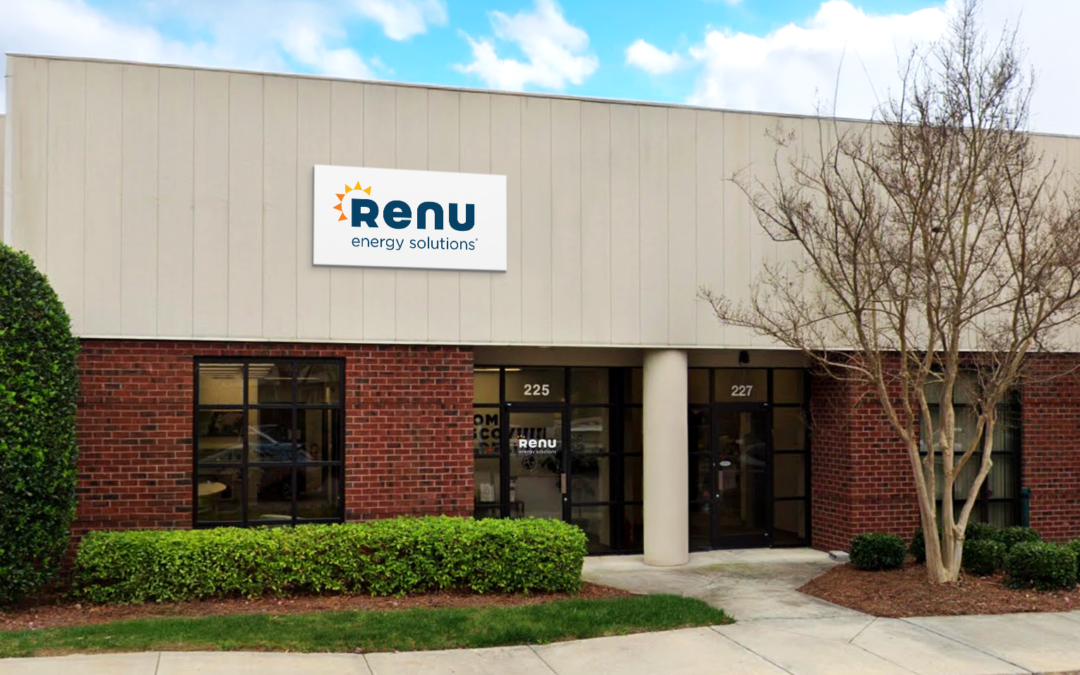
by Renu Energy | Aug 28, 2025 | Solarize, Uncategorized
Written by: Ken Haldin
Campaign Continues to Offer Attractive Incentives to Add Solar and Battery Power Now
Charlotte, NC – Although the time has passed for newly contracted solar energy systems to be fully installed by 2025, there are still multiple ways to maximize savings and reduce home energy costs through Solarize Charlotte-Mecklenburg before this Fall’s enrollment deadline for the program.
Launched this summer by a local partnership consisting of the City of Charlotte, Mecklenburg County, the Town of Davidson, and Centralina Regional Council, the limited-time campaign offers benefits uniquely geared to making renewable energy for homes, businesses and nonprofits more affordable locally.
Among the multiple reasons going solar via Solarize Charlotte-Mecklenburg can provide savings and resiliency:
- Group Discount of up to 20 percent: Group-purchasing discounts have already reached a new 2nd Tier of progressively lower pricing.
- Free and Trusted Evaluations: Those who sign up without obligation by Oct. 31 get a no-cost custom proposal as well as qualify for group discount pricing. All evaluations include projected bill savings over the next 25 years and financial analyses that include payback times and Return on Investment.
- System-Size Discounts: Additional discounts are available for larger system sizes of up to 30 cents per watt.
- Community Support: Via Solarize Charlotte-Mecklenburg, property owners are not “going it alone.” Campaign organizers bring over a decade of solar experience to help ensure projects meet expectations.
- Duke PowerPair Program: Offering up to $9,000 for qualifying solar + battery systems for a limited time. Additional incentives from Duke are also projected to be at capacity within the next 30 days.
- Duke Bridge Rate: A hybrid net metering rate plan will be available only through 2027.
Under the Solarize model, which has been successfully offered through governmental involvement in other North Carolina communities this decade, the more property owners who buy together, the greater the savings for everyone.
As a community-based group-purchasing program, Solarize Charlotte-Mecklenburg utilizes a “tiered” pricing structure. The more participants who buy a system, the lower the price for all. Those who act early may be eligible to receive a rebate from Renu Energy Solutions (the locally headquartered installer selected through vetting) at the end of the campaign. This structure makes the final price per watt the same for every buyer.
So far, more than 225 property owners have signed up to receive a solar energy system proposal through the campaign. Participants who signed contracts to make a purchase have already combined to buy 244.8 kW in system power, which equals 507,952 lbs. of CO2 avoided locally.
Batteries have also been added by many of these homeowners to complement their new systems. A total of 364.5 kWh in battery storage has been produced through the campaign.
The overall no-obligation signup deadline for Solarize Charlotte-Mecklenberg remains Oct. 31. Following this, the deadline for residential contracts to be signed is Dec. 31, 2025. (Property owners considering a system for their business or non-profit organization through the program have later deadlines due to the time needed to consider a larger-scale system.)
Interested property owners should go to the program website to learn more about the campaign and enroll with no obligation. A schedule of informational sessions is also available on the website as well as community appearances scheduled by the campaign’s organizers.
About Solarize Charlotte-Mecklenburg: Solarize Charlotte-Mecklenburg is a community-based campaign developed to help lower the cost of solar energy and battery-storage installations through the power of bulk purchasing, reducing contractor acquisition costs and transferring those savings to residential and commercial buyers. Communities involved include: the City of Charlotte, Mecklenburg County, and Town of Davidson along with others that may join. Centralina Regional Council and Solar Crowdsource are facilitating the program, which launched officially on June 25, 2025.

by Renu Energy | Jun 28, 2025 | Energy Storage, Uncategorized
Overview of Duke Energy’s South Carolina Battery Control Program
Duke Energy offers a Battery Control Program. It is known as Power Manager for Duke Energy Carolinas customers, and EnergyWise Home for Duke Energy Progress customers. The program gives homeowners the opportunity to earn monthly bill credits by allowing Duke to manage a portion of their battery’s stored energy during times of high electricity demand.
These brief “control events” can happen up to 36 times per year and may involve charging, discharging, or holding your battery’s energy for a few hours. Your battery will never be discharged below 20 percent, and you are allowed to opt out of up to four events per year. The program runs automatically in the background and does not affect your battery’s ability to provide backup power.
Eligibility Requirements
To participate, you must:
-
Complete an interconnection application with Duke Energy and stay compliant with interconnection standards
-
Remain enrolled in the program for at least one year
-
Have a qualifying battery system installed
-
Maintain a reliable internet connection with your battery system
Note:
How to Enroll
-
Visit the program website
Choose the link that matches your provider:
-
Click “Enroll Now”
Select your installed battery manufacturer from the list provided.
-
Follow the prompt to continue to your battery’s app or portal
A pop-up window will appear and redirect you to your battery manufacturer’s app or website.
-
Complete the enrollment steps in the app
While the exact steps may vary by battery brand, you will typically need to:
-
Open your battery’s mobile app or web portal
-
Navigate to the section related to battery programs or Virtual Power Plant (VPP) participation
-
Tap or select “Enroll”
-
Confirm or enter your personal information
-
Review and agree to the Terms and Conditions
-
Tap “Complete” or “Submit” to finish enrollment
-
Confirmation
Once submitted, you will see a message like:
“Thank you for applying to the Duke Energy Battery Program. You will receive an email or in-app message with your application status within the next 2 weeks.”
-
Monitor your enrollment status
-
The initial status will show as Pending
-
If accepted, the status will change to Accepted
-
You can revisit your battery’s app to review details or opt out if needed
-
Keep in mind that unenrolling may result in the loss of monthly credits
Questions?
You can visit the program websites listed above or contact Duke Energy by email at PMBattery@duke-energy.com.

by Renu Energy | Jun 17, 2025 | Commericial
Mitrex, a global leader in Building-Integrated Photovoltaics (BIPV) and solar facade systems, has partnered with Domino’s Pizza and Renu Energy to power the world’s first solar-powered Domino’s restaurant, located in Clover, South Carolina. This project marks a major milestone in sustainable commercial architecture, setting a new benchmark for energy-conscious design in the quick-service restaurant industry.
Mitrex Solar Install Transforms Clover, SC Domino’s with Wood-Grain BIPV Panels
Clover, SC – At the heart of the project are Mitrex’s custom-engineered BIPV panels with a wood grain finish, seamlessly integrating solar energy generation into the building’s exterior facade. These panels turn the structure itself into a functional energy asset, generating renewable energy while preserving the building’s architectural integrity. The result is a significant reduction in energy consumption and carbon emissions, setting a new standard for how quick-service restaurants can embrace clean energy without sacrificing aesthetics.
Solar-Powered Domino’s Showcases Real-World Potential of Mitrex Solar Install
More than just a restaurant, this solar-powered Domino’s demonstrates the real-world potential of solar construction materials in commercial applications. The Clover location features integrated solar facade panels mimicking a wood grain finish, as well as rooftop solar panels and EV charging stations. By embracing sustainability and being a pioneer in the industry, Domino’s has set a precedent for future commercial storefronts, showing how solar building skins and BIPV technology can reduce operational costs and carbon footprints.
“Lowest Carbon Emitting Domino’s in the World”
“We might be the lowest carbon emitting Domino’s in the world because the only thing producing carbon emissions is our propane ovens,” said Ryan Swanson, Vice President of marketing and restaurant development.
Renu Energy Ensures Seamless Execution of Mitrex Solar Install
Renu Energy played a crucial role in executing the solar infrastructure, ensuring that all renewable energy systems were efficiently integrated. Their expertise in commercial solar solutions helped optimize energy generation and system performance, supporting the restaurant’s goal of significantly reducing its environmental footprint and moving closer to net-zero energy benchmarks.
Collaboration Between Mitrex, Renu, and Domino’s Sets New Standard for Green Architecture
Mitrex, Renu Energy, and Domino’s are proud to showcase this first-of-its-kind collaboration in sustainable commercial architecture. The success of this project paves the way for future developments, proving that integrating solar energy facades into commercial buildings can deliver lasting environmental impact and economic value.
About Mitrex
At Mitrex, we have developed techniques to integrate aesthetically pleasing solar cladding into building facades and fenestrations. Being the world’s largest building-integrated photovoltaic (BIPV) manufacturer, our advanced BIPV systems offer architects, engineers, building owners, and investors the opportunity to embrace and profit from solar energy without compromising on the grandeur of their project. Innovation and development go conjointly at Mitrex and we continuously make an effort to perform better by combining the latest technology and delivering premium quality solar products. For additional information about the company visit www.mitrex.com
About Domino’s Pizza
Founded in 1960, Domino’s Pizza is the world’s largest pizza company, with more than 21,300 stores across over 90 countries. Domino’s has a strong legacy of pioneering innovations that continue to influence the pizza industry and is committed to including new and emerging technology in its business. The company is actively exploring ways to reduce its environmental impact and improve energy efficiency throughout its operations. For more information, please visit https://www.dominos.com/

by Renu Energy | Jun 13, 2025 | Commericial, Renu Solar News, Residential
Cary, NC – Renu Energy Solutions, a leading solar and energy storage solutions provider, is excited to announce the expansion into the Raleigh-Durham market with the opening of a new office in Cary, NC. This milestone marks a significant step in the company’s growth while reinforcing its commitment to providing sustainable energy to home and business owners across the Carolinas.
Jay Radcliffe, President/CEO of Renu Energy Solutions, gives insight into what the expansion means:
“Our expansion into Cary allows us to better serve the growing demand for solar energy in the Triangle area,” said Jay. “The Raleigh-Durham region is at the forefront of sustainability efforts, and we’re excited to help residents and businesses take control of their energy future with cost-effective, reliable solar solutions.”
The new facility’s grand opening is Wednesday, June 18th, with a full day of visitors scheduled, including community leaders, sustainable energy non-profits, local businesses, existing residential and commercial customers, and prospects alike.
Simplifying Access to Sustainable Energy Solutions
With this expansion, Renu Energy Solutions will provide more accessible and efficient solar installation services, battery storage solutions, and energy efficiency upgrades to customers in the region. The new office ensures quicker response times, a dedicated local team, and a stronger presence in one of North Carolina’s fastest-growing markets.
Cary was selected as the ideal location due to its strong commitment to sustainability, rapidly growing population and increasing interest in renewable energy solutions. Though Renu Energy Solutions had previously served the Raleigh-Durham market, establishing a permanent presence in the neighborhood makes clean energy adoption simpler and more accessible. Previously, materials for installations in the area were supplied from the company’s Charlotte office; now, with a dedicated local facility, all materials will be housed where the installations take place, ensuring greater efficiency and convenience for homeowners and businesses.
Supporting North Carolina’s Clean Energy Transition
As a trusted solar provider with over 15 years of experience, Renu Energy Solutions has helped thousands of homeowners and businesses across the Southeast reduce their reliance on the grid and save on energy costs. The company’s expansion into Cary highlights their mission to advance North Carolina’s clean energy transition while also creating local job opportunities.
Mr. Radcliffe commented about being part of NC’s clean energy movement and the positive impact we are creating in the Cary community:
“We’re proud to be a part of North Carolina’s clean energy movement,” added Radcliffe. “This expansion is not just about business growth, it’s about making a meaningful impact in communities that are ready to embrace a more sustainable future.”
About Renu Energy Solutions
Renu Energy Solutions is a trusted provider of residential and commercial solar energy solutions, offering solar panel installations, battery storage and energy efficiency services. Since 2010, the company has been committed to helping customers gain energy independence while reducing their environmental impact. With a focus on high-quality service and expert craftsmanship, Renu Energy Solutions continues to lead the charge toward a cleaner, more sustainable future.

by Renu Energy | Jun 5, 2025 | Renu Solar News, Residential

House Passes 2025 Sunset for Federal Solar Tax Credit
On May 22, 2025, the House passed a version of the “One, Big, Beautiful Bill,” which would end the Section 25D, Residential Clean Energy Credit on December 31st, 2025. To qualify for the 30% tax credit, the residential system must be placed-in-service by the end of 2025. Prior to becoming law, the bill must pass the Senate and be signed by the President.

Crunched Timeline Creates Dilemma
Senate Timeline and Demand Surge: The Senate’s discussions, expected to extend through the summer until the debt ceiling forces action, will amplify consumer urgency to secure the Residential Solar Tax Credit before potential changes. Historically, policy uncertainty (e.g., ITC step-downs) has driven similar demand surges, straining installation pipelines.
Execution Capacity Constraints: Supply chains and labor shortages can lag behind demand spikes. At the national level, manufacturers and distributors are unprepared for volumes surge. At the local level, permitting offices, utilities and solar installers will experience extended timelines with increased volume.
Consumer Catch-22: Consumers face a dilemma to either sign contracts early to secure “placed in service” installations for the tax credit, or wait for the final bill. The catch is that by the time the final bill becomes law, the consumer may have missed the opportunity to secure a 2025 installation.









